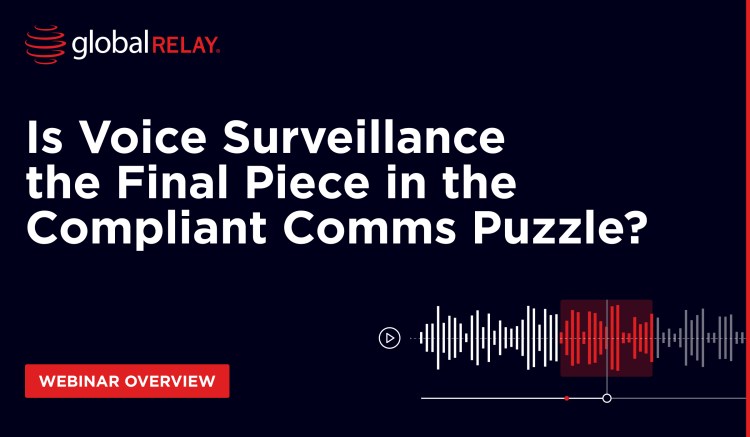On 24 October, 2024, our webinar – ‘Is Voice Surveillance the Final Piece in the Compliant Comms Puzzle’ – brought together voice subject matter experts to discuss prevailing industry trends, growing regulatory expectations, and how technology is changing the voice communications capture game.
You can watch the webinar on-demand here. We’ve brought together some of the key takeaways from the session below.
Panel
- Martin Gaterell, Surveillance and Advisory Compliance expert
- Eren Erman, Global Head of Compliance Technology, TP ICAP
- Robert Nowacki, Senior SME, Global Relay
- Jennie Clarke, Head of Content, Global Relay – Moderator
How are voice communications and written communications compliance different?
The discussion began by looking at the most fundamental question – how voice and written communications channels differ from a compliance and surveillance perspective, and whether voice poses unique risk.
Our panelists discussed that there are considerable differences between how people speak versus written communication, and how speech can introduce unique additional risks. Voice communication is faster, less considered, and often loaded with emotion, whereas written communication offers users the benefit of time to configure messages or responses.
Potential signs of risks like market abuse can be identified through the additional layers of information in spoken communication like sentiment, or bad language. Voice channels present other associated risks, like challenges with vocabulary – such as trading jargon – as well as the accent or language of the speakers.
Voice channels also introduce hardware capture challenges, such as calls taking place in environments that make it difficult to discern speech, such as on a trading floor, or desk phones being answered or used by colleagues they are not assigned to. However, Robert Nowacki believes that these challenges are balanced by the potential that voice capture and surveillance presents.
“Voice capture and surveillance is as exciting as it is challenging” – Robert Nowacki
Historical solutions for contemporary problems
To understand contemporary approaches to voice capture and surveillance, our panelists discussed the discipline’s recent past. They identified that there had been a rapid evolution in recent years.
Formerly, approaches were primarily based on random sampling of calls for potential signs of misconduct. Firms could ‘put an army behind it’ to monitor hundreds of hours of voice calls, but it was a very ‘needle in a haystack’ approach to identifying risk. The advance in quality of voice recordings and speaker attribution have been considerable steps forward for surveillance teams.
Part of the challenge of voice monitoring is that even if monitoring the calls from a very small population size – a small trading team, for example – it results in hundreds of hours of calls, transcripts, and data to sit through. But, expectations have slowly expanded, and firms face the challenges of balancing resource allocation in order to meet regulatory expectations. Previous approaches were inefficient and ineffective – something that the finance space agrees on.
“You can hire an army of hundreds to listen to days’ worth of voice calls and find nothing except some gossip – but you still need to do it, because of regulatory expectations” – Robert Nowacki
How should firms manage voice communication risk?
While firms’ monitoring obligations will depend on the populations they monitor and the jurisdiction they operate in, they should assume they are required to monitor all business conduct and communications and record voice channels. Voice should be considered in parallel with traditional digital communications compliance efforts.
As with implementing any new technology, data can present a challenge for those looking to begin voice capture and monitoring. Initial challenges will include input sources not functioning as intended, obsolete recording systems, poor recording quality, and issues with accurate speaker attribution. All of these are not ‘transcription friendly’, which is a key prerequisite for an effective next-gen voice solution.
The panel discussed how transcription is becoming more accurate and more widely available. While the history of transcription technologies has been poor, acting more as an ‘aide memoir’ to use alongside a call recording, recent developments will be ‘key to good compliance’. While metrics like word error rate can be useful for benchmarking the effectiveness of a transcription solution, they are often not developed specifically with jargon-heavy spaces like financial services in mind, and take a more general approach to language recognition.
Transcriptions need to contain “the words that really matter,” so these can be flagged by surveillance policies and AI for further review where appropriate. The panel agreed that establishing the effectiveness of transcription approaches is initially resource intensive, with a degree of up-front effort to compare transcription accuracy with call recordings side-by-side in order to ensure a low rate of issues like false positives. However, with increasing transcription accuracy, it is a viable and integral part of voice-focused communications monitoring and the ‘new reality’ of compliance.
Are regulators increasing focus on voice communications?
Several recent regulatory moves have hinted that regulators are beginning to shift focus towards voice channels, and that firms may need to start stepping up capture, compliance, and surveillance efforts in anticipation of a coming crackdown.
The panel discussed how improvements in voice capture technology have led to more regulatory interest in – and scrutiny of – voice channels. With high-quality audio capture and transcription solutions more widely available, poor recording quality will not be a sufficient defense for firms when regulators come calling.
While there are currently no regulatory mandates that firms produce transcriptions of voice recordings, most regulated firms are already holding call transcripts, or considering doing so, with smaller firms beginning to catch up – and regulatory expectations doing the same.
Due to voice offering incredibly quick communications and decision-making, it is still the predominant method of trading in some asset classes. It also provides unscrupulous individuals intent on misconduct with a ‘weak link’ in compliance and surveillance posture, as they know it presents firms with challenges in capturing conversations and surveiling for misconduct.
“Voice is about to become a very fundamental part of a compliance package.” – Martin Gaterell
While voice channels may have been the “forgotten element” of communications compliance strategies until now, the panel agreed that, regarding the potential for a regulatory enforcement crackdown on voice, “the wave is coming” – and those firms not already preparing for it should listen well.




